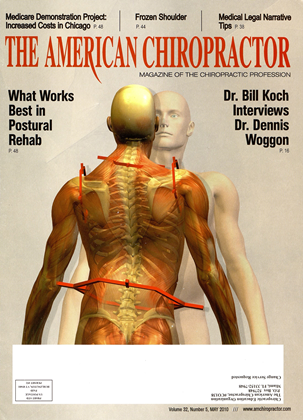A S CHIROPRACTIC PHYSICIANS, WE must be observant of what may be called the "not-so-* obvious" cause(s) of disease. In this short article. I want to present the clinical data and my experience between frozen shoulder (adhesive capsulitis) and diabetes. As a quick review, adhesive capsulitis is a syndrome defined in its purest sense as idiopathic painful restriction of shoulder movement that results in global restriction of the glenohumeral joint. It is not associated with a specific underlying condition. To avoid confusion, the term "adhesive capsulitis" should be used to refer to the primary idiopathic condition and the term "secondary adhesive capsulitis" should be applied to the condition that is associated with, or results from, other pathologic states. Prior to my involvement in functional medicine, I would filter most shoulder conditions through a mechanical lens. I would do the typical orthopedic and biomechanical evaluation and, in many cases, see favorable responses from my treatment. However, the mother of all shoulder problems, adhesive capsulitis, presented the biggest clinical challenge and, I bet, does for many chiropractic physicians. Possible Non-Mechanical Causes of Secondary Frozen Shoulder (FS) The conditions most commonly associated with idiopathic FS are diabetes, hypothyroidism/hyperthyroidism. hypertrig-lyceridemia, CVA with upper-extremity paresis, brachial plexus injury, cervical spinal cord injury, and Parkinson disease. This short discussion will focus on diabetes and its relationship to FS. FACTS: The incidence of adhesive capsulitis is two to four times higher in diabetics than in the general population. The prevalence of diabetes in patients with adhesive capsu litis was 38.6%, whereby the total prevalence of a diabetic condition in patients with adhesive capsulitis was 71.5% Shoulder capsulitis is common in type 1 and type II diabetic patients. However, it is associated with age in type I and 11 diabetic patients and with the duration of diabetes in type I patients. Possible Etilogy Diabetics have a higher incidence of frozen shoulder, prob- ably because poor circulation leads to abnormal collagen repair and degenerative changes. The theory is that platelet derived growth factor is released from abnormal or ischemic blood vessels, which will then act as a stimulus to local myofibroblast proliferation. What follows has been proposed that microvascular disease, abnormalities of collagen repair and predisposition to infection may link diabetes with frozen shoulder. The take away from this article is to be aware of these findings alerting you to the risk of diabetes in patients presenting with adhesive capsulitis of the shoulder. Ronald Grisanti D.C., D.A.B.C.O., M.S., has29years of clinical practice and extensive functional medicine training and experience has positioned him as an authority /// llic management of a vcirielv of chronic health conditions .such as fibromyalgia, arthritis, digestive disorders, anxiety and other common ailments. He senses on the South Carolina Chiropractic Investigative Committee. For more information on free training go to unvr.FunctionalMedicineTraining. com/A C-Primer. References: Parada-Turska J, Majdan M. The musculoskeletal system in diabetic patients, Postepy Hig Med Doxw. 59:236-44. 2005 Sattar MA. Luqman WA. Pcriarthritis: another duration-related complication of diabetes mcllitus. Diabetes Care. Sep-Oct:8(5):507-10. 1985 Milgrom C. Novack V. Weil Y. Jaber S. Radeva-Peirova DR. Fine-stone A, Risk factors for idiopathic frozen shoulder. Ixr Med Assoc J, May:10(5):361-4. 2008 Cole A. Gill TK. Shanahan EM. Phillips P, Taylor AW, Hill CL. Is diabetes associated with shoulder pain or stiffness? Results from a population based study. J Rheinmiiol. Feb:36(2):371-7, 2009 Tighe C'B. Oakley WS Jr. The prevalence of a diabetic condition and adhesive capsulitis of the shoulder. South MedJ. Jun:IOI(6):591-5. 2008 Mavrikakis ME. Sfikakis PP. Kontoyannis SA, Antoniades LG, Kontoy-annis DA. Moulopoulou DS. Clinical and laboratory parameters in adult diabetics with and without ealeific shoulder periarthritis. Ccilci)'TissueInt. Oct;49(4):288-9I. 1991 Balci N. Balci MK.TiiziinerS. Shoulder adhesive capsulitis and shoulder range of motion in type II diabetes mellitus: association with diabetic complications. J Diabetes Complications. May-Jun; 13(3): 135-40. 1999 Moren-Hybbinette I. Moritz U, Schersten B. The painful diabetic shoulder. Ada MedSaim/.2I9(5):5O7-I4. 1986 Arkkila PE. Kantola IM. Viikari JS. Ronnemaa T. Shoulder capsulitis in type I and II diabetic patients: association with diabetic complications and related diseases, Ann Rheum Dis, Dec;55(12):907-14. 1996 | The incidence of adhesive capsulitis is two to four times higher in diabetics than in the general population.
 View Full Issue
View Full Issue









